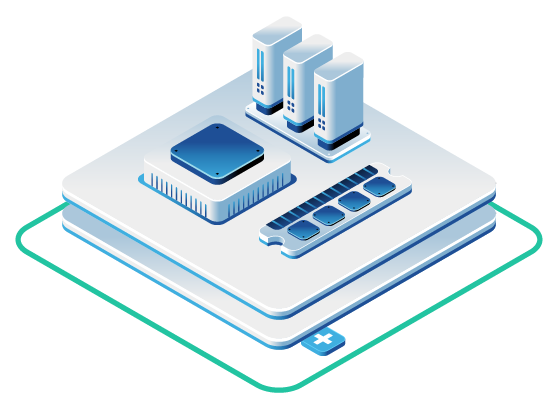In this article
- The Computational Demands Driving HPC Adoption
- Architectural Foundations For HPC Excellence
- Storage Strategies For Massive Datasets
- Financial Modeling And Quantitative Analysis
- Scientific Computing Across Domains
- Deployment Strategies And Best Practices
- Cost Considerations And Scaling Strategies
- Implementation Roadmap
- Support And Operational Excellence
When your scientific simulations or financial models demand more computational power than traditional cloud offerings can provide, you need infrastructure that delivers both raw performance and complete control. Private HPC clusters have become the backbone of breakthrough research and sophisticated financial analysis, where milliseconds matter and accuracy cannot be compromised.
The Computational Demands Driving HPC Adoption
Modern computational challenges require infrastructure that can handle massive datasets, complex algorithms, and demanding real-time processing. Research institutions face computational workloads that span climate modeling, genomics, and physics simulations, while financial institutions leverage HPC for risk management, fraud detection, and algorithmic trading, where speed and accuracy directly impact competitiveness.
The fundamental difference between HPC and typical cloud workloads lies in their resource requirements. HPC applications often need dedicated hardware access, predictable performance patterns, and the ability to tune every layer of the stack from BIOS to application. Unlike web applications that can tolerate shared resources and variable performance, HPC workloads demand consistency and control.
Scientific computing applications frequently require enormous memory pools to keep entire datasets in active computation. Computational fluid dynamics simulations might need to maintain complex mesh structures in memory, while Monte Carlo financial models process thousands of scenarios simultaneously. These workloads cannot afford the performance penalties introduced by virtualization overhead or the unpredictable resource allocation common in public cloud environments.
Architectural Foundations For HPC Excellence
Building an effective private HPC cluster starts with understanding your specific computational requirements and designing the infrastructure to match. The architecture must accommodate both current needs and future scaling requirements while maintaining the performance characteristics your applications demand.
Hardware Specifications That Matter
Memory capacity often determines the scale of problems you can tackle. At OpenMetal, we’ve built our infrastructure to support high-performance computing workloads with configurations optimized for different HPC scenarios. Our XXL V4 servers feature dual 32-core/64-thread Xeon Gold 6530 processors with 2TB of DDR5 RAM and 38.4TB of NVMe storage across six 6.4TB Micron 7450 MAX drives. These configurations provide the massive memory capacity that memory-bound simulations require.
For teams building HPC clusters incrementally, our XL V4 systems with 1TB RAM and Large V4 systems with 512GB RAM serve as building blocks that can scale to XXL configurations as computational demands grow. We can deliver HPC-optimized custom configurations, including nodes with 3TB or more of RAM and high-performance Micron 7500 NVMe drives, depending on specific workload requirements.
The Bare Metal Advantage
Virtualization introduces what’s known as the hypervisor tax – performance overhead that can significantly impact HPC applications. Our bare metal approach eliminates this overhead by providing direct hardware access. This allows teams to tune NUMA topology, set CPU affinity, and optimize memory allocation for their specific algorithms.
With full root access and BIOS control, research teams can compile custom scientific libraries, optimize kernel parameters, and achieve true bare metal performance for MPI-based parallel workloads. This level of control is particularly important for applications that need to squeeze every bit of performance from the underlying hardware.
Network Infrastructure for Distributed Computing
HPC applications often distribute computation across multiple nodes, requiring low-latency, high-bandwidth interconnects for efficient message passing. Our private networking features dual 10Gbps NICs per server, providing 20Gbps total bandwidth with unmetered traffic between servers. Each customer gets isolated VLANs, eliminating noisy neighbor concerns that can plague public cloud HPC deployments.
This network architecture supports MPI frameworks and other distributed computing paradigms that require predictable, low-latency communication between compute nodes. Modern HPC clusters rely on high-speed networking such as Ethernet and InfiniBand to enable efficient data distribution and synchronization between processing nodes.
Storage Strategies For Massive Datasets
HPC workloads generate and consume enormous amounts of data. Scientific simulations might produce terabytes of checkpoint data, while financial models ingest massive historical datasets and generate detailed analysis results. Storage infrastructure must balance performance, capacity, and resilience.
We’ve deployed complete HPC environments using dedicated Ceph storage clusters that provide the resilience and scalability across terabytes or petabytes of data that HPC simulations require. These storage clusters handle massive checkpointing operations, dataset ingestion, and output storage with the throughput and reliability that production HPC environments demand.
The storage architecture must accommodate different data access patterns. Raw simulation data might be accessed sequentially in large blocks, while checkpoint files need rapid random access. Analysis results might be written once but read many times for visualization and post-processing. A well-designed storage hierarchy matches these patterns with appropriate storage technologies.
Financial Modeling And Quantitative Analysis
Financial institutions increasingly rely on HPC for complex quantitative analysis, pricing derivatives, and risk modeling. The ability to run Monte Carlo simulations with millions of scenarios, perform real-time risk calculations, and execute sophisticated trading algorithms depends on computational infrastructure that can deliver consistent, predictable performance.
Banks face competitive pressures that make computational speed a direct competitive advantage. Firms with more capable HPC can run deeper analysis faster, model more scenarios pre-trade, and make better-informed decisions in rapidly changing markets. The accuracy of financial models often depends on the number of scenarios and iterations that can be computed within available time windows.
Value-at-risk calculations, stress testing, and regulatory compliance modeling all demand both computational capacity and precision. Modern financial institutions must process enormous datasets to meet regulatory requirements while maintaining the speed necessary for competitive trading and risk management operations.
Our fixed-cost model with aggregated egress allowances prevents the runaway costs common in public clouds where financial collaborations can generate massive data transfer fees. HPC teams can provision new nodes or expand clusters in 45 seconds for initial deployment and 20 minutes for scaling, unlike on-premises systems that take weeks or months to scale.
Scientific Computing Across Domains
Scientific applications span an enormous range of computational requirements. Molecular dynamics simulations using GROMACS, AMBER, or NAMD benefit from GPU acceleration for nonbonded force calculations and particle mesh Ewald summation. These applications are typically designed to work effectively with mixed precision arithmetic, allowing them to run efficiently on modern GPU hardware.
Computational fluid dynamics applications like those built on OpenFOAM or commercial packages like ANSYS Fluent require different resource profiles. CFD simulations often need large amounts of memory to store complex mesh structures and may require double precision arithmetic throughout the computation for numerical stability.
Climate modeling, genomics, and physics simulations each have specific requirements for memory, storage, and computational precision. Understanding these requirements helps determine the optimal hardware configuration and resource allocation for your specific research domain.
Our V4 and V3 generations give researchers the flexibility to create “monster VMs” with custom CPU-to-RAM ratios that public clouds simply can’t match. Our OpenStack platform allows HPC teams to provision enormous instances that would be impossible in standard public cloud catalogs, such as virtual machines with 1TB or more of RAM for computational fluid dynamics or Monte Carlo simulations that need to keep entire datasets in memory.
Deployment Strategies And Best Practices
Container Orchestration for Reproducible Computing
Modern HPC deployments benefit from containerization technologies that ensure reproducible computational environments. Researchers need to pin their software stack including container image digests, CUDA versions, and solver versions to ensure reproducible results across different runs and research teams.
Our containerized OpenStack deployment via Kolla-Ansible provides both repeatability and customization flexibility that HPC users need. Teams can define standardized computing environments while retaining the ability to customize configurations for specific applications or research requirements.
Resource Management and Job Scheduling
Effective HPC clusters require sophisticated job scheduling and resource management. Systems like SLURM, PBS, or Kubernetes handle job queuing, resource allocation, and workload distribution across cluster nodes. The scheduler must understand application requirements and match them with available hardware resources.
Job schedulers also handle priority management, fair share allocation among research groups, and resource accounting. These capabilities become particularly important in multi-user environments where different research projects compete for computational resources.
Performance Monitoring and Optimization
Continuous monitoring helps identify performance bottlenecks and optimization opportunities. Modern HPC environments require monitoring tools that can track CPU utilization, memory usage, network throughput, and storage performance across all cluster nodes.
Performance profiling tools help researchers understand where their applications spend computational time and identify opportunities for optimization. This might involve tuning compiler options, adjusting algorithm parameters, or modifying resource allocation to match application characteristics.
Cost Considerations And Scaling Strategies
Predictable Costs vs. Cloud Billing Surprises
Public cloud HPC can generate unexpected costs through variable pricing, data transfer fees, and resource over-provisioning. Scientific collaborations that generate massive datasets can face substantial data transfer costs when moving data between regions or downloading results.
Private HPC clusters provide predictable operational costs that scale with actual usage rather than peak resource allocation. This cost predictability helps research organizations budget effectively and avoid the billing surprises that can derail research projects.
Scaling Methodologies
HPC clusters must accommodate changing computational demands. Research projects might need intensive computation during specific phases, while financial institutions face variable computational loads based on market activity and regulatory reporting cycles.
Effective scaling strategies balance capital efficiency with performance requirements. Starting with a smaller cluster and adding nodes as computational demands grow often provides the best balance of cost and capability.
Infrastructure Flexibility
Different research domains and financial applications have varying infrastructure requirements. Some applications benefit from GPU acceleration, while others perform better on high-memory CPU nodes. Storage requirements might favor high-bandwidth parallel filesystems or large-capacity object storage.
Building flexibility into the infrastructure architecture allows research teams to adapt their computational resources as project requirements evolve. This might involve adding specialized GPU nodes for machine learning workloads or increasing memory capacity for larger simulations.
Implementation Roadmap
Phase 1: Requirements Assessment and Pilot Deployment
Begin by thoroughly understanding your specific computational requirements. Workload assessment should examine whether applications are computation-intensive, data-intensive, or require mixed workloads. Understanding performance requirements, memory needs, and I/O patterns helps determine the optimal hardware configuration.
Start with a pilot deployment that can handle representative workloads. This allows teams to validate performance characteristics, test operational procedures, and refine the infrastructure configuration before full-scale deployment.
Phase 2: Full Cluster Deployment and Integration
Expand the cluster based on lessons learned from the pilot deployment. This phase involves installing and configuring all cluster nodes, setting up the job scheduler, and implementing monitoring and management tools.
Integration with existing research workflows and data management systems ensures that the HPC cluster enhances rather than disrupts established procedures. This might involve connecting to existing data storage systems, integrating with authentication infrastructure, or customizing job submission procedures.
Phase 3: Optimization and Scaling
Continuous optimization helps ensure that the cluster delivers maximum performance for your specific workloads. This involves tuning application parameters, optimizing job scheduling policies, and refining resource allocation strategies.
As computational requirements grow, scaling the cluster involves adding nodes, expanding storage capacity, or upgrading network infrastructure. Planning for future growth ensures that expansion can occur with minimal disruption to ongoing research activities.
Support and Operational Excellence
Expert Guidance Throughout Deployment
Building and operating HPC clusters requires specialized expertise across hardware configuration, software optimization, and operational management. Our engineer-to-engineer support through dedicated Slack channels provides direct access to infrastructure experts who understand both hardware requirements and operational challenges of running production scientific computing clusters at scale.
Engineer-assisted onboarding helps teams navigate the complexity of HPC cluster deployment and configuration. This hands-on support accelerates time-to-productivity and helps avoid common configuration issues that can impact performance or reliability.
Ongoing Operational Support
Effective HPC operations require monitoring, maintenance, and troubleshooting capabilities. Our support model includes free trial options and ramp pricing for teams migrating from public cloud environments, making it easier to evaluate the platform and plan migration strategies.
The combination of technical expertise and flexible support options helps research teams focus on their scientific work rather than infrastructure management. This operational support becomes particularly valuable for teams that need HPC capabilities but lack dedicated systems administration expertise.
Private HPC clusters represent a strategic investment in computational capability that pays dividends through improved research productivity, predictable costs, and complete control over the computational environment. Whether you’re conducting groundbreaking scientific research or developing sophisticated financial models, the right private HPC infrastructure provides the foundation for computational excellence.
For organizations ready to move beyond the limitations of public cloud HPC or expand beyond on-premises constraints, private HPC clusters offer the performance, control, and cost predictability that advanced computational work demands. The key is partnering with an infrastructure provider that understands both the technical requirements and operational challenges of production HPC environments.
Schedule a Consultation
Get a deeper assessment and discuss your unique requirements.
Read More on the OpenMetal Blog


































